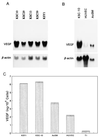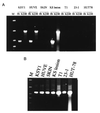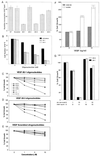Vascular endothelial growth factor/vascular permeability factor is an autocrine growth factor for AIDS-Kaposi sarcoma
- PMID: 9023368
- PMCID: PMC19625
- DOI: 10.1073/pnas.94.3.979
Vascular endothelial growth factor/vascular permeability factor is an autocrine growth factor for AIDS-Kaposi sarcoma
Abstract
Kaposi sarcoma (KS) is the most common tumor associated with HIV-1 infection and develops in nearly 30% of cases. The principal features of this tumor are abnormal vascularization and the proliferation of endothelial cells and spindle (tumor) cells. KS-derived spindle cells induce vascular lesions and display enhanced vascular permeability when inoculated subcutaneously in the nude mouse. This finding suggests that angiogenesis and capillary permeability play a central role in the development and progression of KS. In this study, we show that AIDS-KS cell lines express higher levels of vascular endothelial growth factor/vascular permeability factor (VEGF/VGF) than either human umbilical vein endothelial cells or human aortic smooth muscle cells. AIDS-KS cells and primary tumor tissues also expressed high levels of Flt-1 and KDR, the receptors for VEGF, while the normal skin of the same patients did not show any expression. We further demonstrate that VEGF antisense oligonucleotides AS-1 and AS-3 specifically block VEGF mRNA and protein production and inhibit KS cell growth in a dose-dependent manner. Furthermore, growth of KS cells in nude mice was specifically inhibited by VEGF antisense oligonucleotides. These results show that VEGF is an autocrine growth factor for AIDS-KS cells. To our knowledge, this is the first report that shows that VEGF acts as a growth stimulator in a human tumor. Inhibitors of VEGF or its cognate receptors may thus be candidates for therapeutic intervention.
Figures





Similar articles
-
Vascular endothelial growth factor and basic fibroblast growth factor present in Kaposi's sarcoma (KS) are induced by inflammatory cytokines and synergize to promote vascular permeability and KS lesion development.Am J Pathol. 1998 Jun;152(6):1433-43. Am J Pathol. 1998. PMID: 9626048 Free PMC article.
-
Strong expression of kinase insert domain-containing receptor, a vascular permeability factor/vascular endothelial growth factor receptor in AIDS-associated Kaposi's sarcoma and cutaneous angiosarcoma.Am J Pathol. 1996 Apr;148(4):1065-74. Am J Pathol. 1996. PMID: 8644848 Free PMC article.
-
Modulation of in vivo growth of thyroid tumor-derived cell lines by sense and antisense vascular endothelial growth factor gene.Oncogene. 1999 Aug 26;18(34):4860-9. doi: 10.1038/sj.onc.1202869. Oncogene. 1999. PMID: 10490819
-
The role of vascular endothelial growth factor (VEGF) in AIDS-related Kaposi's sarcoma.Oncologist. 2000;5 Suppl 1:28-31. doi: 10.1634/theoncologist.5-suppl_1-28. Oncologist. 2000. PMID: 10804088 Review.
-
Possible involvement of VEGF-FLT tyrosine kinase receptor system in normal and tumor angiogenesis.Princess Takamatsu Symp. 1994;24:162-70. Princess Takamatsu Symp. 1994. PMID: 8983073 Review.
Cited by
-
Disseminated cutaneous Kaposi sarcoma in a patient receiving triptolide/tripdiolide for rheumatoid arthritis.Med Sci Monit. 2012 Aug;18(8):CS67-71. doi: 10.12659/msm.883256. Med Sci Monit. 2012. PMID: 22847205 Free PMC article.
-
Immune Reconstitution Inflammatory Syndrome Associated Kaposi Sarcoma.Cancers (Basel). 2022 Feb 16;14(4):986. doi: 10.3390/cancers14040986. Cancers (Basel). 2022. PMID: 35205734 Free PMC article. Review.
-
Phase II AIDS Malignancy Consortium trial of topical halofuginone in AIDS-related Kaposi sarcoma.J Acquir Immune Defic Syndr. 2011 Jan 1;56(1):64-8. doi: 10.1097/QAI.0b013e3181fc0141. J Acquir Immune Defic Syndr. 2011. PMID: 21068672 Free PMC article. Clinical Trial.
-
An update on nonmelanoma skin cancer.J Clin Aesthet Dermatol. 2011 Feb;4(2):20-7. J Clin Aesthet Dermatol. 2011. PMID: 21386954 Free PMC article.
-
Phase II trial of imatinib in AIDS-associated Kaposi's sarcoma: AIDS Malignancy Consortium Protocol 042.J Clin Oncol. 2014 Feb 10;32(5):402-8. doi: 10.1200/JCO.2012.48.6365. Epub 2013 Dec 30. J Clin Oncol. 2014. PMID: 24378417 Free PMC article. Clinical Trial.
References
-
- Safai B, Johnson K G, Myskowski P L, Cunnungham-Randles S, Godbold J H, Dupont B. Ann Intern Med. 1985;103:744–750. - PubMed
-
- Haverkos H W, Drotman D P, Morgan M. N Engl J Med. 1985;312:1518–1523. - PubMed
-
- Ruszczak Z, Silva A M, Orfanos C E. Am J Dermatopathol. 1987;9:388–398. - PubMed
-
- Kaplan L D, Hopewell P C, Jaffe H, Goodman P C, Bottles K, Volberding P A. J Acquired Immune Defic Syndr. 1988;1:23–30. - PubMed
Publication types
MeSH terms
Substances
Grants and funding
LinkOut - more resources
Full Text Sources
Other Literature Sources
Medical
Research Materials

